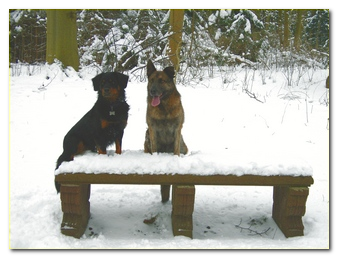Canine behavioural therapy
DogLogix is specialized in solving undesired canine behavioural problems. Canine behavioural therapy is used to change the undesired behaviour into desired behaviour. Examples are:
- aggressive/unfriendly behaviour towards dogs, people or other animals;
- separation anxiety (the dog can’t be alone);
- fear of dogs, people or other animals;
- fear of noise (e.g. fireworks, thunder);
- not coming on commando;
- excessive excited behaviour
- excessive barking, whining and howling;
- urinating in the house;
- pulling on the leash;
- (general) disobedience.
Problem analysis
It is important to find your dog’s motivation to perform the undesired behaviour. Only then it is possible to find a good therapy to change this undesired behaviour.
Learning a dog to behave in a desired way is usually the solution to the problem. Teaching it not to do the undesired behaviour will not solve the problem. By creating the right circumstances and by supporting your dog we will make the dog behave like we want. This way the dog can be rewarded a lot and this will make it want to perform the wanted behaviour more than the unwanted behaviour.
The same result is much harder to achieve in a group lesson at a dog school. In the case of undesired behaviour an individual approach is needed. An approach custom-made for your situation, your dog and its behavioural problem.
Referral
It is also possible that part of the advice is a referral to a veterinarian or dog physiotherapist. I do this when I think medication can support the training of your dog. Or when I think that pain can be a part of the behavioural problem.
Practical
 Canine behavioural therapy exists of three appointments. In these appointments I’ll diagnose and explain the problems, teach you the new way of interaction with your dog and lead you in practice through the excersises.
Canine behavioural therapy exists of three appointments. In these appointments I’ll diagnose and explain the problems, teach you the new way of interaction with your dog and lead you in practice through the excersises.
This way I can guide you through the training and adjust your training habbits. And of course keep you motivated untill the right result is met.
The first appointment will last about 2 hours and will take place at your house. Together we look at the history of your dog and the behavioural problems. I would also like to know your expectations and desires so that I can adjust the therapy to get the best results. This personal approach will make sure the chosen way of approach and targets are reachable for you and your dog.
Of course I would also like to see the behavioural problems. It is also possible that you videotape the behaviour. At home I’ll write the complete diagnoses and training for you and send it by email.
Follow-up appointments, questions and support
The second appointment is usually one week after the first session. The third appointment will be three or four weeks after the second appointment. The appointments are arranged like this because behaviour change (for your dog and for you) needs at the least three weeks to settle.
For questions and support you can always mail, text, whatsapp or call me.